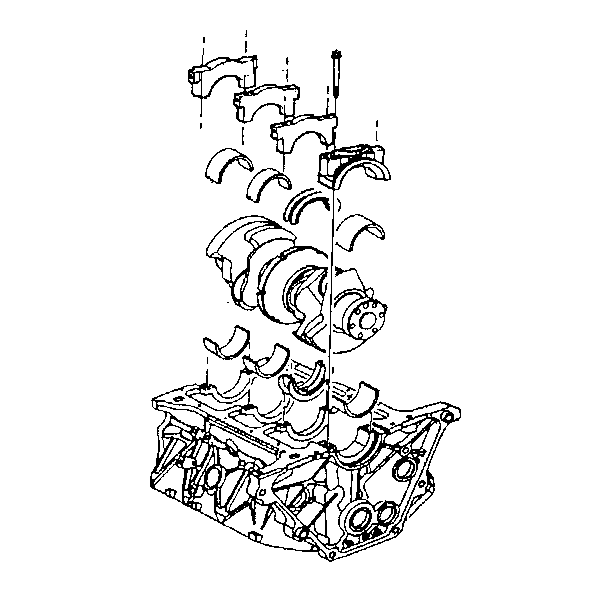- Dip the bearing cap bolts in clean engine oil.
- Place the bearing inserts into the bearing cap and into the engine block.
- In the case of a thrust bearing type main bearing insert, coat the thrust surface with GM EOS P/N 1052368 or equivalent.
- Lubricate the bearing surface with clean engine oil.
- Install the crankshaft.
- Install the main bearing caps. Apply a small amount of sealer GM P/N 1052942 to the rear of the #4 bearing cap sealing surface.
- Install the main bearing cap bolts.
- Measure the crankshaft end play.
Notice: Do not scrape, shim, or file bearing inserts. If the bearing surface of the insert is touched with bare fingers, the skin oil and acids will etch the bearing surface.
Important: Ensure that the bearing cap bolt holes and the cap mating surfaces are clean and dry.
Notice: Upper and lower inserts may be different. Do not obstruct any oil passages.
Important: The inserts will project slightly when put into place. Ensure that they project an equal distance on both sides. Ensure that the insert tangs are engaged.

Notice: In order to prevent the possibility of cylinder block or crankshaft bearing cap damage, the crankshaft bearing caps are tapped into the cylinder block cavity using a brass, lead, or a leather mallet before the attaching bolts are installed. Do not use attaching bolts to pull the crankshaft bearing caps into the seats. Failure to use this process may damage a cylinder block or a bearing cap.
Tighten
Use the J 36660-A
in
order to tighten the main bearing cap bolts to 50 N·m (37 lb ft)
plus 77 degrees.
Notice: Use the correct fastener in the correct location. Replacement fasteners must be the correct part number for that application. Fasteners requiring replacement or fasteners requiring the use of thread locking compound or sealant are identified in the service procedure. Do not use paints, lubricants, or corrosion inhibitors on fasteners or fastener joint surfaces unless specified. These coatings affect fastener torque and joint clamping force and may damage the fastener. Use the correct tightening sequence and specifications when installing fasteners in order to avoid damage to parts and systems.
